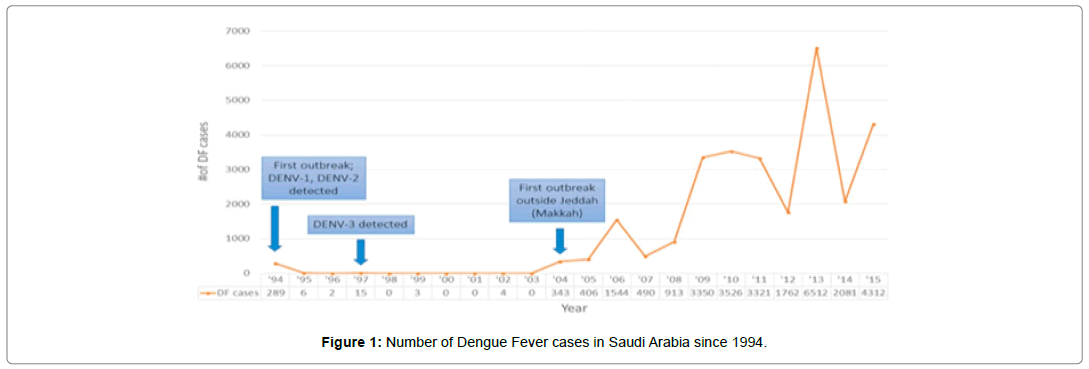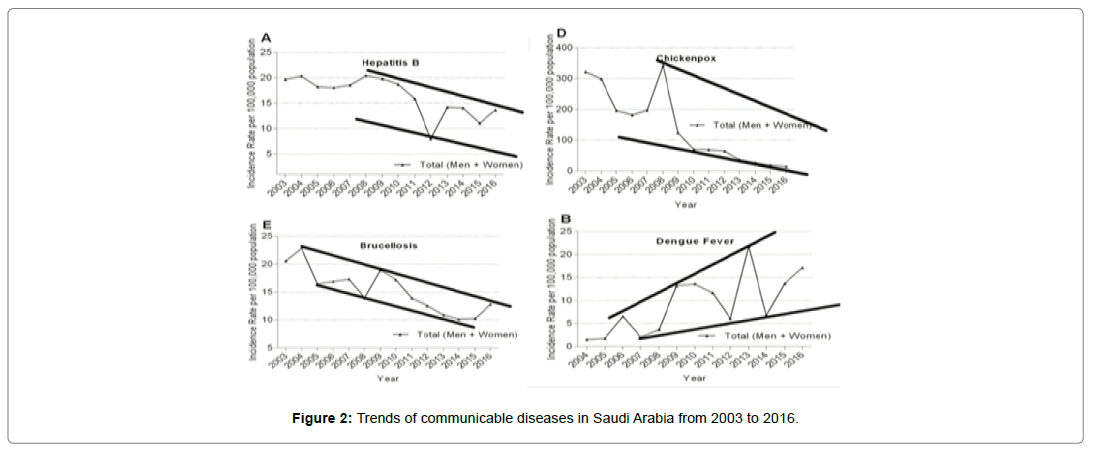Dengue Fever and the Future of Hajj
Received: 27-Jun-2021 / Accepted Date: 15-Jul-2021 / Published Date: 26-Jul-2021 DOI: 10.4172/2471-9846.1000294
Abstract
Dengue fever (DF) is a viral, tropical, and subtropical mosquito-borne disease. The DF transmission has increased radically with incidence growing 30-fold over the past 50 years. Currently, an estimated 50–100 million infections take place annually and DF is now categorized as the most important vector-borne viral disease in the world. The first documented case of DF in Saudi Arabia was in 1993. Climate, socio-demographic factors, and increasing urbanization has influenced the spread of DF in Saudi Arabia. The expected future environmental changes over the coming years and the high number of Hajj performers targeted by the Saudi government as well as Hajj time advances to the peak months of DF create a serious threat to pilgrims’ health and a large burden on the Saudi Arabia health system.
Keywords: Dengue fever; Hajj; Saudi vision 2030; Southwestern region of SA
Introduction
Dengue fever (DF) is a mosquito-borne viral disease that occurs mainly in tropical and subtropical areas worldwide. The Aedes albopictus and Aedes aegypti are responsible for an acute febrile illness defined as DF [1]. Age, genetic disposition, and immune status are some of the risk factors associated with DF and humidity and hot climate, as humidity can increase the mosquito’s life span and reduce the viral replication period [2]. The dengue virus belongs to family of viruses known as Flaviviridae. There are four distinct serotypes of the dengue virus, DENV-1, DENV-2, DENV-3, and DENV-4. The transmissibility and severity of the disease vary based on the genetic variations between serotypes [3]. High fever, severe muscle and joint pain, severe headache, and rash are the most common manifestations of infection with dengue fever [3]. Dengue fever is a self-limiting disease with an incubation period of 5 to 8 days. DF may complicate into dengue shock syndrome (DSS) or dengue hemorrhagic fever (DHF) [1]. Altassan [2] claimed that dengue fever in Saudi Arabia is one of the largest disease burdens in the Middle East. Dengue fever was first described in 1779 in Batavia, followed by a pandemic in Philadelphia, USA, a year later. Another pandemic of DF happened in 1998 involving 56 countries where 1.2 million people were infected [1].
In Saudi Arabia, a male patient visited a health clinic in Jeddah in November 1993 complaining of fever, hemorrhagic signs, and nonspecific symptoms. A few weeks later the patient has passed away due to hepato-renal failure that believed to result from viral hepatitis. Further investigation in collaboration with the Yale arbovirus research unit revealed that the patient had been infected with the dengue virus (DENV). This incident was the first isolation of DENV in Saudi Arabia. By February 1994, a surveillance system was established; it recorded nearly 300 cases of DF in Jeddah that year [2].
Small outbreaks of DF have been reported in the succeeding years, followed by bigger outbreaks between 2004 and 2015, mainly during rainy seasons reaching nearby cities Makkah, Al-Madinah, Jizan, and Najran, which lead the Saudi Ministry of Health to declare the western region of Saudi Arabia endemic for DF [2].
This paper will explore the DF threat to Hajj as environmental conditions change, resulting in higher temperatures. Also, the time of Hajj in the coming years will be within the seasonal peak of DF infected cases, and the Saudi Arabia government is aiming to welcome a large number of pilgrims.
Literature Review
Stagnant water collection, poor sanitation, urbanization, migration, climate change, and growing vector population contribute to the dramatic increase in DF worldwide over the past 50 years [2].
Moreover, temperature, humidity, and rainfall are factors enabling the transmission of DF; for instance, rainfall provides pockets for stagnant water around human residences [2].
In addition, the west coast of Saudi Arabia maintains a consistent climate with high humidity and 30–40°C throughout the year [2].
Moreover, over the next 60 years a 4°C increase in average temperature is projected along with higher average rainfall in the south and southwestern regions of SA, where the DF is already endemic [2].
Furthermore, Khormi & Kumar (2012) concluded an increase in population density is significantly associated with higher DF incidence [1].
Vector control is the center of DF prevention strategies as there is no treatment for DF, and the vaccine cannot be used in many places [4].
The total number of Haji pilgrims in 2018 was 2,371,675, of which 1,758,722 (74%) were from outside Saudi Arabia, with about 20,000 more than in 2017 and 200,000 more than in 2016 [5].
On the other hand, Umrah performers during the year 2018 reached about 19 million people, with 40% from outside Saudi Arabia and 42% within the 30–49-year-olds group [6].
One of the main Saudi government “vision 2030” goals is increasing the number of Hajj and Umrah performers to reach 6 and 30 million, respectively [7].
Epidemiological Data
Since the first outbreak of DF in Saudi Arabia in late 1993, there were few to no cases of DF reported until 2004, when another outbreak occurred, followed by many outbreaks as the number of reported cases continued climbing and new geographical regions become involved (Figure 1) [2].
In 2018 there were 5345 cases of DF reported with 4942 cases in Jeddah alone (92.4%) followed by Jazan, Makah, Madinah, Najran. and Taif (with 174, 163, 41, 14, and 11 cases respectively); all cities are within south and southwestern region [5]. Moreover, most cases were notified in April, followed by May, June, July, March, February, and January sequentially, and around 100 cases/month for the rest of 2018 [5]. Additionally, around 71% of individuals infected were aged 15–45 years old, followed by the age group < 45 years old with 21% of reported cases [5]. Furthermore, non-Saudi males ranked highest in comparison to Saudi males, Saudi females, and non-Saudi females. The incidence rate among non-Saudis was 32.8/100,000 population and 5.7/100,000 population among Saudis (Figure 2) [5].
Many communicable diseases have shown a descending trend in Saudi Arabia over the last 15 years, such as hepatitis B, chickenpox, and brucellosis. On the contrary, DF has an alarming rising trend [4].
Discussion
The pilgrimage takes place according to the Hijri calendar in the twelfth month of each year, which differs from the Gregorian calendar by 11 days. During 2006–2011 the pilgrimage took place at a time of a slight rise in cases of DF. In recent years, there have been few cases of DF at the time of Hajj. The Hajj is anticipated to be in year 2030 at the time of the peak of dengue [2].
Many clinical trials are ongoing to develop an effective vaccine because the only current vaccine (Dengvaxia) has 60% efficacy and limited uses. Thus, vector control must be a top priority in preventing DF [2].
Moreover, future environmental changes, such as global warming, altering rainfall patterns, and DF outbreaks in new regions, as mentioned earlier, raise the need for further studies and investigation on the impact of these changes on the DF incidence.
Conclusion
In this paper, I have described dengue fever and the causes and factors that helped its spread in the western and southern regions of Saudi Arabia, especially the city of Jeddah. Additionally, I have discussed the expected future environmental changes and the Saudi government’s vision 2030 through the Hajj and Umrah program. Ultimately, I believe DF is a serious threat to pilgrims’ health in future years as Hajj time advances to the peak months of DF. In addition, the high number of Hajj performers targeted by the Saudi government might further complicate the situation.
References
- Alhaeli A, Bahkali S, Ali A, Househ M, El-Metwally A (2016) The epidemiology of Dengue fever in Saudi Arabia: A systematic review. J Infect Public Health 9: 117-24.
- Altassan K, Morin C, Shocket M, Ebi K, Hess J (2019) Dengue fever in Saudi Arabia: A review of environmental and population factors impacting emergence and spread. Travel Med Infect Dis 30: 46-53.
- Cromar L, Cromar K (2020) Dengue Fever and Climate Change. Climate Change and Global Public Health. 273-310.
- Herzallah H, Antonisamy B, Shafee M, Al-Otaibi S (2019) Temporal trends in the incidence and demographics of cancers, communicable diseases, and non-communicable diseases in Saudi Arabia over the last decade. Saudi Med J 40: 277-286.
- Ministry of Health. Annual statistical book. Riyadh: Ministry of Health; 2018.
- General Authority for Statistics.Umrah statistics bulletin. Riyadh: General Authority for Statistics; 2018.
Citation: Alzahrani MS (2021) Dengue Fever and the Future of Hajj. J Comm Pub Health Nursing 7: 294. DOI: 10.4172/2471-9846.1000294
Copyright: © 2021 Alzahrani MS. This is an open-access article distributed under the terms of the Creative Commons Attribution License, which permits unrestricted use, distribution, and reproduction in any medium, provided the original author and source are credited.
Share This Article
Recommended Journals
Open Access Journals
Article Tools
Article Usage
- Total views: 2273
- [From(publication date): 0-2021 - Feb 22, 2025]
- Breakdown by view type
- HTML page views: 1673
- PDF downloads: 600


